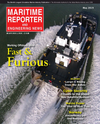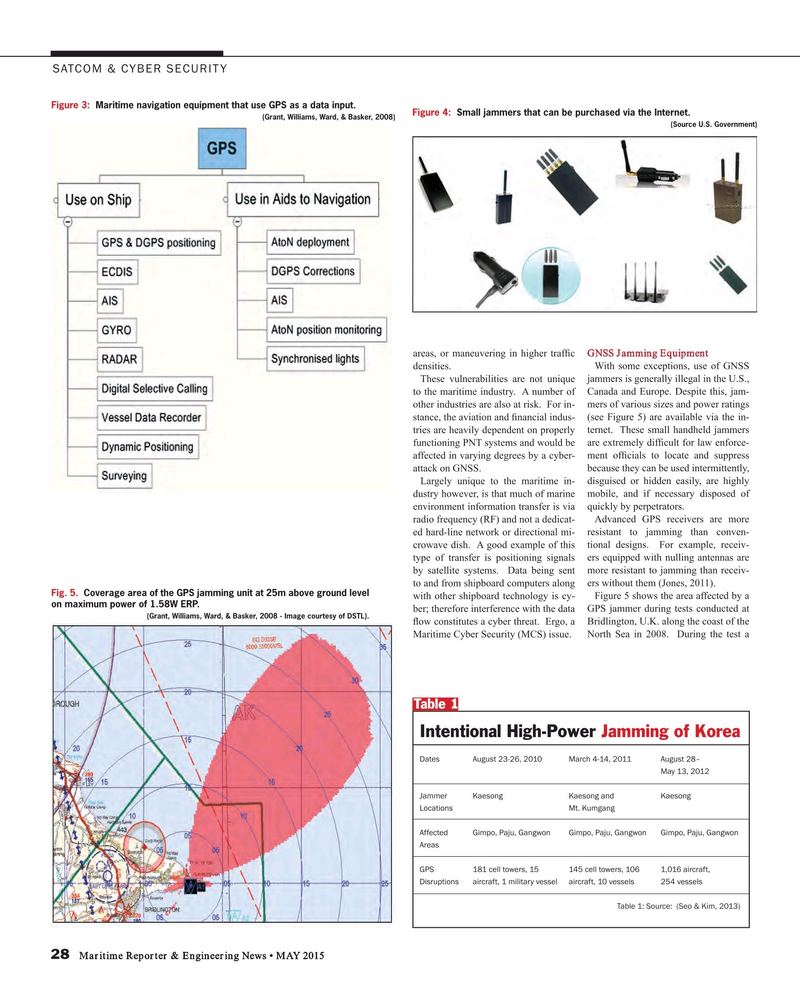
Page 28: of Maritime Reporter Magazine (May 2015)
The Marine Propulsion Edition
Read this page in Pdf, Flash or Html5 edition of May 2015 Maritime Reporter Magazine
SATCOM & CYBER SECURITY
Figure 3: Maritime navigation equipment that use GPS as a data input.
Figure 4: Small jammers that can be purchased via the Internet. (Grant, Williams, Ward, & Basker, 2008) (Source U.S. Government) areas, or maneuvering in higher traf? c GNSS Jamming Equipment densities. With some exceptions, use of GNSS
These vulnerabilities are not unique jammers is generally illegal in the U.S., to the maritime industry. A number of Canada and Europe. Despite this, jam- other industries are also at risk. For in- mers of various sizes and power ratings stance, the aviation and ? nancial indus- (see Figure 5) are available via the in- tries are heavily dependent on properly ternet. These small handheld jammers functioning PNT systems and would be are extremely dif? cult for law enforce- affected in varying degrees by a cyber- ment of? cials to locate and suppress attack on GNSS. because they can be used intermittently,
Largely unique to the maritime in- disguised or hidden easily, are highly dustry however, is that much of marine mobile, and if necessary disposed of environment information transfer is via quickly by perpetrators.
radio frequency (RF) and not a dedicat- Advanced GPS receivers are more ed hard-line network or directional mi- resistant to jamming than conven- crowave dish. A good example of this tional designs. For example, receiv- type of transfer is positioning signals ers equipped with nulling antennas are by satellite systems. Data being sent more resistant to jamming than receiv- to and from shipboard computers along ers without them (Jones, 2011).
Fig. 5. Coverage area of the GPS jamming unit at 25m above ground level with other shipboard technology is cy- Figure 5 shows the area affected by a on maximum power of 1.58W ERP. ber; therefore interference with the data GPS jammer during tests conducted at (Grant, Williams, Ward, & Basker, 2008 - Image courtesy of DSTL).
? ow constitutes a cyber threat. Ergo, a Bridlington, U.K. along the coast of the
Maritime Cyber Security (MCS) issue. North Sea in 2008. During the test a
Table 1
Intentional High-Power Jamming of Korea
Dates August 23-26, 2010 March 4-14, 2011 August 28– May 13, 2012
Jammer Kaesong Kaesong and Kaesong
Locations Mt. Kumgang
Affected Gimpo, Paju, Gangwon Gimpo, Paju, Gangwon Gimpo, Paju, Gangwon
Areas
GPS 181 cell towers, 15 145 cell towers, 106 1,016 aircraft,
Disruptions aircraft, 1 military vessel aircraft, 10 vessels 254 vessels
Table 1: Source: (Seo & Kim, 2013) 28 Maritime Reporter & Engineering News • MAY 2015
MR #5 (26-33).indd 28 MR #5 (26-33).indd 28 4/30/2015 10:31:38 AM4/30/2015 10:31:38 AM

 27
27

 29
29
